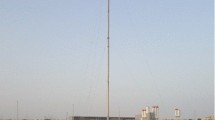Abstract
A two-dimensional numerical model for simulating flow and pollutant dispersion in an urban street canyon is firstly developed using the FLUENT code and then validated against the wind tunnel results. After this, the flow field and pollutant dispersion inside an urban street canyon with aspect ratio W/H = 1 are examined numerically considering five different shapes (vaulted, trapezoidal, slanted, upward wedged, and downward wedged roofs) as well as three different roof height to building height ratios (Z H /H = 1/6, 1/3, and 1/2) for the upstream building roof. The results obtained reveal that the shape and height of an upstream roof have significant influences on flow pattern and pollutant distribution in an urban canyon. A large single clockwise vortex is generated in the canyon for the vaulted upstream roof at Z H /H = 1/6, 1/3, and 1/2, the trapezoidal and downward wedged roofs at Z H /H = 1/6 and 1/3, and the slanted and upward wedged roofs at Z H /H = 1/6, while a main clockwise vortex and a secondary counterclockwise vortex are established for the trapezoidal and downward wedged roofs at Z H /H = 1/2 and the slanted and upward wedged roofs at Z H /H = 1/3 and 1/2. In the one-vortex flow regime, the clockwise vortex moves upward and grows in size with increasing upstream roof height for the vaulted, trapezoidal, and downward wedged roofs. In the two-vortex flow regime, the size and rotational velocity of both upper clockwise and lower counterclockwise vortices increase with the upstream roof height for the slanted and upward wedged roofs. At Z H /H = 1/6, the pollution levels in the canyon are close among all the upstream roof shapes studied. At Z H /H = 1/3, the pollution levels in the canyon for the upward wedged roof and slanted roof are much higher than those for the vaulted, trapezoidal, and downward wedged roofs. At Z H /H = 1/2, the lowest pollution level appears in the canyon for the vaulted upstream roof, while the highest pollution level occurs in the canyon for the upward wedged roof.






















Similar content being viewed by others
References
Assimakopoulos VD, ApSimon HM, Moussiopoulos N (2003) A numerical study of atmospheric pollutant dispersion in different two-dimensional street canyon configurations. Atmos Environ 37:4037–4049
Huang YD, Zhou ZH (2013) A numerical study of airflow and pollutant dispersion inside an urban street canyon containing an elevated expressway. Environ Model Assess 18(1):105–114
Huang YD, Hu XN, Zeng NB (2009) Impact of wedge-shaped roofs on airflow and pollutant dispersion inside urban street canyons. Build Environ 44:2335–2347
Karra S, Malki-Epshtein L, Neophytou M (2011) The dispersion of traffic related pollutants across a non-homogeneous street canyon. Procedia Environ Sci 4:25–34
Kastner-Klein P, Plate EJ (1999) Wind-tunnel study of concentration fields in street canyons. Atmos Environ 33:3973–3979
Niachou K, Livada I, Santamouris M (2008) Experimental study of temperature and airflow distribution inside an urban street canyon during hot summer weather conditions. Part II: Airflow analysis. Build Environ 43(8):1393–1403
Rafailidis S (1997) Influence of building areal density and roof shape on the wind characteristics above a town. Bound-Layer Meteorol 85:255–271
Rafailidis S, Schatzmann M (1995) Study on different roof geometries in a simplified urban environment. http://www.mi.uni-hamburg.de/fileadmin/files/static_html/windtunnel/
Takano Y, Moonen P (2013) On the influence of roof shape on flow and dispersion in an urban street canyon. J Wind Eng Ind Aerodyn 123:107–120
Venegas LE, Mazzeo NA, Dezzutti MC (2014) A simple model for calculating air pollution within street canyons. Atmos Environ 87:77–86
Xie SD, Zhang YH, Li Q, Tang XY (2003) Spatial distribution of traffic-related pollutant concentrations in street canyons. Atmos Environ 37:3213–3224
Yassin MF (2011) Impact of height and shape of building roof on air quality in urban street canyons. Atmos Environ 45:5220–5229
Acknowledgments
This work was supported by the National Natural Science Foundation of China (Grant No. 50908147) and the Innovation Program of Shanghai Municipal Education Commission (Grant No. 10ZZ95).
Author information
Authors and Affiliations
Corresponding authors
Additional information
Responsible editor: Michael Matthies
Rights and permissions
About this article
Cite this article
Huang, Yd., He, Wr. & Kim, CN. Impacts of shape and height of upstream roof on airflow and pollutant dispersion inside an urban street canyon. Environ Sci Pollut Res 22, 2117–2137 (2015). https://doi.org/10.1007/s11356-014-3422-6
Received:
Accepted:
Published:
Issue Date:
DOI: https://doi.org/10.1007/s11356-014-3422-6




